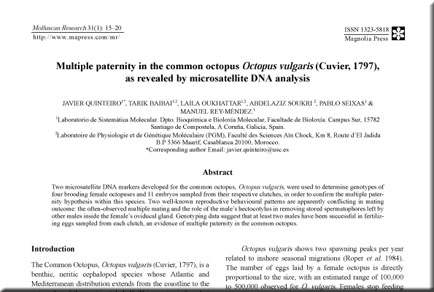Abstract
Two microsatellite DNA markers developed for the common octopus, Octopus vulgaris, were used to determine genotypes of four brooding female octopuses and 11 embryos sampled from their respective clutches, in order to confirm the multiple pater-nity hypothesis within this species. Two well-known reproductive behavioural patterns are apparently conflicting in mating outcome: the often-observed multiple mating and the role of the male’s hectocotylus in removing stored spermatophores left by other males inside the female’s oviducal gland. Genotyping data suggest that at least two males have been successful in fertiliz-ing eggs sampled from each clutch, an evidence of multiple paternity in the common octopus.

